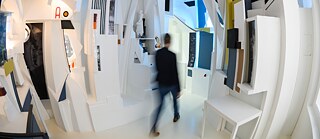The mushrooming Merzbau by German artist Kurt Schwitters is an ingenious act of artistic rebellion. But how does it fit into a world where everything’s supposed to be minimalist and tidy? Author Saskia Trebing takes a look at this architecture of excess.
Kurt Schwitters and Marie Kondo never met each other. And how would they have? After all, in the case of the former, we are talking about a German artist who was one of the most notable exponents of Dadaism. Unfortunately, Schwitters died in 1948. The latter is a Japanese woman from the Greater Tokyo area who was born in 1984. Kondo has made a name as an expert in tidying, becoming a bestselling author and Netflix star with her tips on inner and outer order. “Does it spark joy?” — the question Kondo asks about every stray object — has become a mantra in over-decorated living rooms worldwide.Art Dominated the Architecture
Despite their incompatible biographies, it would be nice to sit Schwitters and Kondo down at a table with their beverage of choice in some alternative universe. The thing is, in Kondo’s system of perfectly rolled T-shirts and strictly regulated belongings, Kurt Schwitters and his fondness for proliferation would be a particularly challenging case.It was likely around 1923 that the artist began the incremental transformation of an apartment on his parents’ property in Hanover into an art installation, which he called Merzbau. The artwork, comprised of varied materials, resembled a three-dimensional abstract painting in which geometric shapes compete for attention, define each other, and perpetually reproduce. At some point, the delineations become indiscernible: The art dominates the architecture and gives way to an entirely new space.
Although this strategy of eternal growth surely wasn’t conducive to living comfortably (the artist was clearly struggling with his mental health clearly at times), Schwitters achieved something extraordinary with his installation, in terms of design. On the one hand, he created the first walk-in collage in the history of Western art, which resembled a surrealist cathedral and evoked the Formenrausch [in English: a term coined by German philosopher Friedrich Nietzsche to describe the ecstasy of creating designs or forms] behind expressionist film sets. At the same time, the Merzbau can be interpreted quite literally as a cave — an almost archaic structure into which an animal continually hauls new materials to build a never-ending nest.
In 1937, Kurt Schwitters, defamed by the Nazis who called him a “degenerate,” fled to Norway. Two further Merzbau installations were created there, in Lysaker near Oslo and on an island off the coast of Molde. The artist made a last attempt at a Merz Barn at his final residence, Elterwater in England. None of the works has survived intact.
A Radical Love of Excess
If you abide by Marie Kondo’s ideology that liberation from material ballast can lead to inner peace, then you probably would have advised Schwitters to make a lifestyle change. After all, art contains plenty of examples of minimalism in which reduction can lead to aesthetic focus and spiritual experiences. On the other hand, the Merzbau installations demonstrate a radical love of excess, which is similarly cathartic. They are a means of escape from a world that demands order and optimization and in which the accumulation of possessions is devalued as pathological hoarding.For Schwitters, art was something that called for absoluteness, and he was literally in over his head. Everything has its place, even under this logic. However, at some point, the forms only exist as a whole and can no longer be viewed independently of each other. They become bigger than their creator himself. Even Marie Kondo would have found it impossible to tidy up a Merzbau.
Does It Spark Joy?
Even 75 years after his death, Schwitters’ works still command fascination from artists in a big way. Maybe it’s one of those rare instances in which opulence is possible without evoking an association with capitalist greed. The desire for “more and more” in artistic terms is a risky condition that can lead to the creation of monstrosities. Conversely, it can also lead to the creation of an entirely new world. Something like the Merzbau can only come into being if an individual breaks free from the confines of social norms and refuses to limit their creativity any longer. Norwegian author Karl Ove Knausgaard once said of his autofiction novel series Min Kamp [in English: My Struggle], which is several thousand pages long, that his initial notes about his life seemed too banal, and he wanted to shorten them. But then, he had a key realization: “If something isn’t interesting enough, don’t do less of it. Do more. More and more.”If Marie Kondo wants to take a closer look at the chaotic Mr. Schwitters and his material proliferation, there’s a replica of the Merzbau in the Sprengel Museum in Hanover. Plus, the Henie Onstad Senter near Oslo hopes to preserve what’s left of his house in Lysaker and open it to the public.
That just leaves the perennial Kondo question: Does it spark joy? Yes, without a doubt. And also irritation, unease, and fascination — as you’d expect from good art.
Related Links
09/2023
